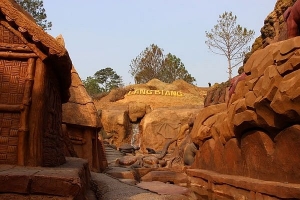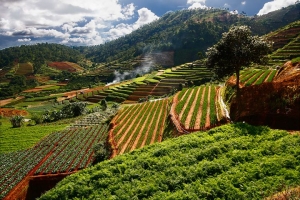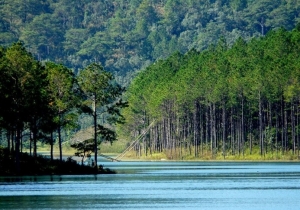DaLat's history narrated by sculpted path
Located near the famous Tuyen Lam Lake, the path embodies the vision of its founder Trinh Ba Dung to tell the history of the city in a uniquely creative way.
Sculptures on the walls of the path purport to tell the story of Da Lat from more than 100 years ago, when the area was wild and teeming with wildlife, when it was sparsely inhabited by the Co Ho ethnic minority.

Various Co Ho myths including the fleeing of the father tortoise and his children while the mother tortoise fights a huge snake are etched into the wall. The story indicates that the Co Ho were a matriarchal society.
The French colonial days are indicated with sculptures of landmark buildings like the Da Lat College, Da Lat Railway Station, Pasteur Institute and old villas by the Xuan Huong Lake.
The highest sculpture on the walls is 12m tall.

"In the section featuring the city after 1975, sculptors made schools of fish like salmons, sturgeons, fields of strawberry, tea and coffee plantations. One striking image is that of an Airbus 321, 32m long, on a high peak representing the Lien Khuong airport," said Dung, chairman of the Sao Da Lat Joint-Stock Company, which owns the sculpture complex.
Dung said his vision was to make a "minimised dictionary" of Da Lat for tourists and children to understand and love the city more.
Work on this complex began in 2010 and more than 100 artisans were on the site during its busiest times.

"We relied on real models and made calculations to carve them here in suitable portions," said Nguyen Luong Ninh, responsible for the "technology" and methods used at the site.
The first work was a 90sq.m house made of soil, furnished with beds, chairs, tables, wardrobes, washing basins and chimneys, which are all made of soil. The house stands against a mountain and faces the lake. There is a map of Viet Nam on its roof. The house has been recognised as "The First and the Most Unique House Made of Basaltic Soil without Baking" by the Viet Nam Record Book Centre.
"The only material used is red basaltic soil, which is close to nature. I think the work is a unique way to prevent soil erosion here," Dung said.
The complex won a Green Architecture Award from the Viet Nam Architects Association in April this year.
Ngo Doan Duc, vice chairman of the association, said he highly appreciated Dung's brainchild as it used local natural soil to create a cultural and artful space that matches the surrounding landscape.

Mr. Trinh Ba Dung, chairman of the Sao Da Lat Joint-Stock Company
"However, if Dung had co-ordinated with architects and building specialists, his complex would have been designed better," Duc said.
"I also doubt the stability of the upright sculptured walls carved on the hills. He's very brave to have done that."
Dung was not too worried. He said he has developed a technology of making structures with soil, using a process where it is hardened and covered with a special paint that can endure wind, rain and humidity.
He also hopes to apply his technology to build other tourism sites in Ha long Bay, Nha Trang and even outside the country.
The last sections of the road are still under construction, but the site has already begun attracting visitors since the beginning of this year.
"Sometimes I wear a worker's outfit and wander round the site and chat with tourists," he said, "They don't know that I'm the owner. Some of them said the owner of the tunnel must be crazy to invest so much money and labour in such a work for the city."
After completing the "tunnel" early next year, Dung intends to submit a file and claim a Guinness Record for the longest sculptured road in the world.
Dung said he has travelled a lot and was most impressed by the Keukenhof Garden in the Netherlands with its world famous tulips. When he came to Da Lat, he recognised that the city has a good red basaltic soil, which sometimes bothered him while travelling.
"Then I thought red basalt can be a special local product if it is hardened and decorated," he said.
"There are many miniature works for tourism throughout the world, so why can't I do something here in Da Lat, I thought.
"That is the beginning of my sculpture road story."
A day as a gardener at Trai Mat (Lam Dong province)
From the city downtown, people can follow Tran Hung Dao and Hung Vuong streets to get to the site after a 20-minute drive on motorbike. Tourists can also take a bus or train to get there.
Along the way, people can admire beautiful pine trees and French-style villas looming under the shades or they can see local farmers planting vegetables on the hills or students with rosy cheeks wearing woolen coats walking on the street.
After strolling on a small path leading to Linh Phuoc Pagoda, tourists will arrive in a valley where they are lost in a vast area of vegetables like carrot, cabbage, strawberry, onion and amaranth.
They can wander along the farm and talk with local people or pick ripped strawberries and carrot by themselves.
People can buy strawberry as present for family and friends at the price from VND150,000 per kilo at the garden.
Then, tourists are advised to visit a nearby market and Linh Phuoc Pagoda, a seven-level tower which was built from glass pieces and a giant Buddha of Mercy statue made from aster flowers.
A farmer showers his garden in Trai Mat

Tourists can pick strawberries at the garden at the price of VND150,000 per kilo

After visiting Trai Mat, tourists are advised to pass by Linh Phuoc Pagoda, one of the popular sightseeing spots in the locality
Tranquility in Tuyen Lam lake (Lam Dong province)
Truc Lam Zen Monastery is also a must-visit destination of the tourist site, where tourists can admire tranquility and peace in mind.
Source: SGT








































































































